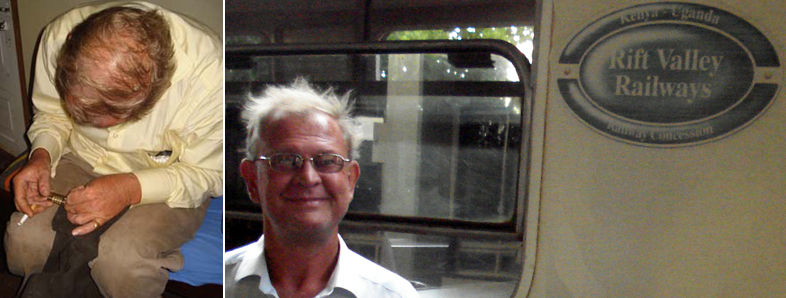
| Golf home |
Crtd 09-02-06 Lastedit 19-02-09
Nairobi [ Go to:
List of Nairobi Pages]
Private appendix to Wikipedia
Everything you always wanted to know about anything is of course in Wikipedia, just type "Nairobi". But here's my personal appendix. Dom had invited me to travel with him to Nairobi. He would be busy, there, but I would have time to look around and visit Annemarie, a friend from Holland who had recently moved there. The start would be a party in Kampala's tourist lodge Red Chili. Dom anticipated a difficult wake up at 5:30 AM, and before taking even his first drink there had bought bus tickets, hired a taxi, prepared his bag of stand by travel items, including water and sandwiches for him and me. At five, I heard him stumbling in our room. He fell on his bed, even managed to get his shoes and socks out, and had half an hour's sleep.

Photo left: departure Kampala: Dom 5:30 AM
after heavy party and half an hour sleep trying to open his number lock
Photo right: departure Kisumu 18:00 PM: That's better!
He can hardly have any memories of our 6 hours bus trip to Kisumu, where, at six PM, we mounted a private 2nd class Rift Valley Railways sleeper cabin with beds and room service. A hour before Nairobi, Dom went off for his Nairobi suburb Karen (after Karen Blixen), where his parents live. The train went on. Suddenly, at my South side, I saw this:
View from train window entering Nairobi (1). Photo Southward over Kibera slum. Horizon: Nairobi National Park
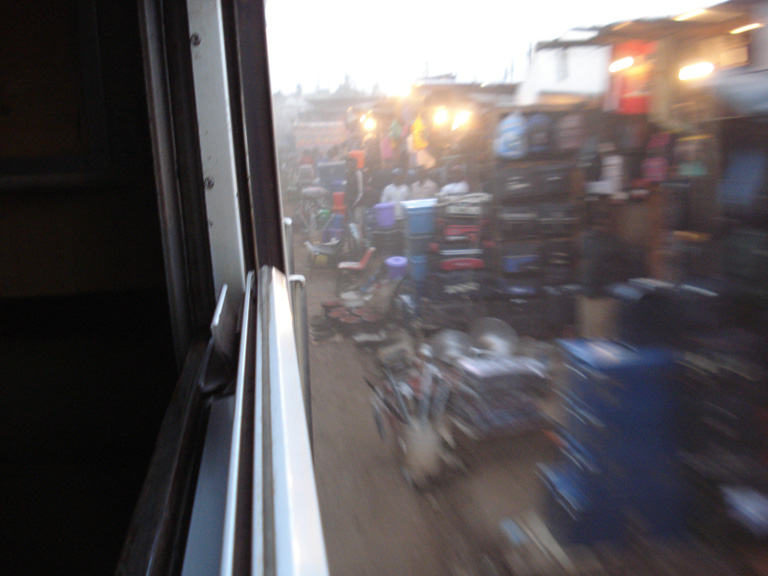
Train enters Nairobi (2). Rail in use as shopping mall corridor
The train drove through a shopping street where the items on display actually
reached the rail. Shoppers must be using the railway itself for walking, and be
chased off by passing trains.
Arrival at Nairobi Railway Station. I cut myself a way through
the taxi drivers to have my first walk through the town centre, which is like
that any other modern western town. Wide lanes, sky scrapers, shiny office
buildings, new cars neatly lined up in huge traffic jams, its drivers avoiding
eye contact with each other, no smoking everywhere (including your own car!), no
bikes, well paved pedestrian road sides. Unpaved areas green, seldom muddy or
dusty. Hardly any whites though. They prefer
to live and locate their businesses outside the town centre.
Nairobi centre: spacey lanes, close to (?) a million good cars, posh office buildings, Obama everywhere, hopeless traffic jams, conspicuous integrity, no smoking, whites stay out.
The favourite rich man's shop is Nakomatt, a dense supermarket chain - ran by
Indians of course - with shops
that come in different sizes. Guarded parking, shiny malls and prices at least
200% of Kampala. The cheaper shops of small Indians are more difficult to find.
Clothes I would buy in the slums. People are excellently dressed there and the
stalls are cheap. The 20 dollar Nakomatt "Nike" polo hangs there for one and you
get your trendy shorts for two. I did not get the impression that the range of
products for sale in Nairobi is wider than in Kampala. A Nakomatt mall burnt
down during my stay. The radio urged people to stay away. Dano, Annemarie's
friend, photographer, was there, I later heard, without camera, so he could not take
pictures of the two streams
of public: running out for the fire and in for the looting. I waited for sunset
because I was told you have to get out of Nairobi's city centre at 4 PM, which
turned out to be exaggerated. Yes, unlike in Kampala where everything stays open
until late, shops close sunset or slightly after. But hotels and restaurants are
open in the evening. At sunset the city is still totally clogged with traffic,
and is is hard to believe they could be out before 8:30. Anyway, no fearsome
atmosphere at all.
How to find Annemarie's home from the city centre? I had street name and a map.
In Kampala the street name would be enough: a bodobodo (moped taxi) would know, and take you for half a dollar per kilometer
along the jams. You would sit back
and look around. In Nairobi, no bodobodo. Private hire car taxis charge double for blacks and
triple for whites (for double they take the black and refuse the white), and
then take you for an indefinite period in the traffic jam. So, I decided to walk
in the right direction, even though I had 10 km to go, until the car traffic
would exceed my walking speed. This happened only 5 km later, after having
enjoyed all those irritated faces of those whose corruption had yielded them
a shiny Mercedes, Land Cruiser or Prado, and were now condemned to life in the
jam. I had left the centre, crossing the Uhuru (independence) park, with its
famous paved smoking zone (see picture above).
There, indeed taxis refused me for the black tariff, so I looked for a bus. A
bus costs 10% of taxi, but you need to know the route number system used
by large buses and small "12" (but really 24) person bus taxis alike.
A girl
told me it was 62 and after strictly following our route on my map I stepped out
where I should.
Like everywhere in Nairobi, Annemarie's side street is locked with a gate attended by
two armed guards with a visitor's book. I have to call her and let her
talk to the street guards. Her street features two-story single family houses
with a garden in front and at the back. Many such fenced compounds in Nairobi
have three or four five story buildings containing a number of apartments on
each level. In the suburbs where compounds are larger, you see several quick
response vehicles (from different security companies) with up to four armed
guards on every street. Everybody there has a "safe room" where you lock
yourself in and call. 4 minutes is the standard, everybody does one trial alarm
per month. There are heavy fines if guards turn up late. The typical robbery
assault is by people armed with spears and pangas, inexperienced and unaware of all these measures taken against them. Few days go by without such
easy prey for the guards.
Time for more study of yet another Nairobi map. I had thought of neatly cutting out the map of my
hotel's yellow pages, but this had already been done before me, and I fell back
on using the highly
defective one in my free hotel guide. Curiously enough, maps of
Nairobi do not feature the slums - not even their main streets - though 55% of the
3 million of its inhabitants live there.
Nairobi. In orange the two main slums, Kibera and Mathare (5% of N'bi-surface, 55% of its inhabitants).
Where there were no Arabs or whites, there were no towns in Africa. With very
few exceptions, a town (a non agricultural settlement that needs food supply
from outside) is not an African thing. Nairobi started as a railroad terminal
after the rail reached there from Mombassa in 1899. The town was planned by the
English, divided in white, Indian and black sections. 8 years later, the Nairobi
golf club was founded. At the time Nairobi had 11.500 inhabitants. It became
royal in 1936, when Nairobi had 60.000. Now there are over 3 million. Reckoned
from 1907, that is an average annual growth rate of almost 6%, more than 3 times
the world's average.
I did play my golf with Annemarie. Fortunately I am a good looser (she has
handicap 7). But I had my share of pride because she was very happy to beat me!
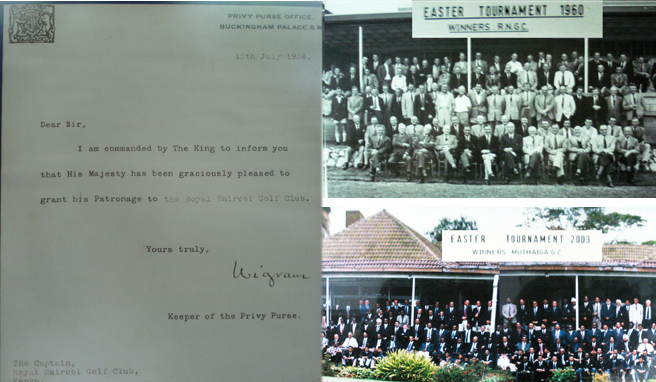
Royal Nairobi Golf Club, founded 1907: changed colour but royal ever since 15th July 1936.
The Royal Nairobi Golf Club borders with the Kibera slums (see Google Earth picture below but also map). The border is a 2.5 m high wall, but it has a small gate that opens during day time. Most staff and caddies live in Kibera, and in the morning, they enter through this gate (see arrow) - my caddy not excluded, so I offered to hire him as a caddy, for the next day, through Kibera..
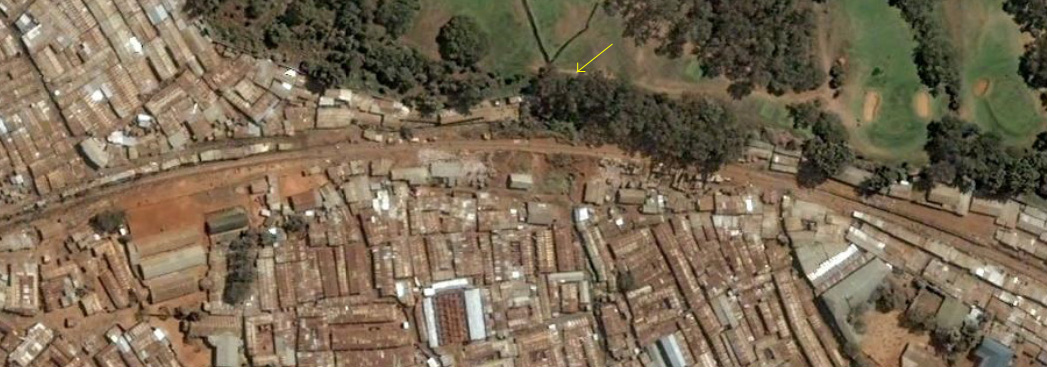
Up: RNGC golf course, down: Kibera slums, railroad clearly visible. At the arrow: THE gate (sorry, I now realize a ground picture of THE gate should be here on this page, and will be after my next visit).
The next day we strolled through the lush meadows of the course, passed through
THE gate, and entered a different world. housing, patched corrugated iron roofs
on walls made of clay filled, cement plastered plaited branches, is normal to African
standards. The difference is in scale. A million people together here, narrow
pass ways between houses, were there are a rush hours (most work outside the
slum) resembling soccer stadium
entry times in the morning and evening. In day time, local shopkeepers, child
watchers and other old people stay behind. Most people have a cemented toilet
pit and shower, or share it with some neighbours. Sewage and drainage is done by
digging trenches in the ground, that erode during heavy rains. Road side
structures, like platforms for sewing clothes or selling products, are often laid
over the sewage-drainage trenches. Inside, houses have solid dry clay or cement
with floor covering, beds, TV, and a wood stove with chimney leading through
wall or roof. The metal roofs render the houses hot in the afternoon. And
indeed the Kisumu train rail is one long shopping street. Kibera is car-free! If I were invited by
someone to stay there for a week, I would have no reason of discomfort to
refuse. A week.
We went back though the golf club gate. Strolling again between the courses we
discussed the civil war after the elections of 2008. This was mainly between Luo and
Kikuyu. Both tribes occupy large parts of the slums. The city buses are ran by
Kikuyus. The Kikuyu thought it wise not to have their tribesmen fight and
intimidate neighbour-Luo. They used their city buses to bring Kikuyus to other
places to fight the Luos. Thus the Kibera adult male Kikuyus were "on duty"
elsewhere and replaced by adult male Kikuyus unknown in Kibera. My caddy is of neither
tribes thus threatened from both sides. He fled with wife and 8 children, and a
few bags. His house got burnt and looted. Meanwhile, his family stayed elsewhere
and he was earning frantically for his reinvestment, caddying on the Royal
Nairobi golf course. Smoke rose at the other side of THE gate. More than once,
golfers had to line up for a second time because they had their
concentration disturbed by a gunshot. "But now it is all over and we are all friends
again".
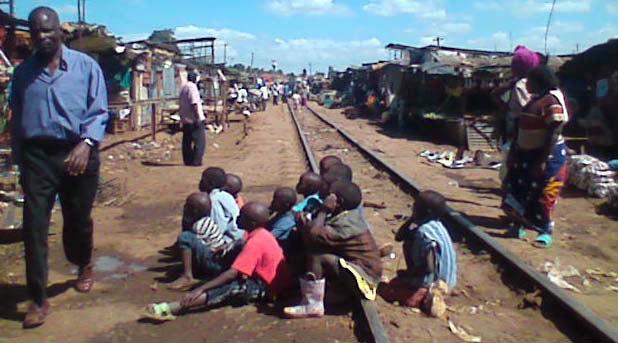
Watching a shop's TV (Kibera)
Time to go back to Uganda. Departure at Nairobi railway station. The train will leave from platform 3. There is a pedestrian tunnel but it is not very popular. You simply cross the two railways in between the platforms. If trains are standing, you pass through or under. In the middle of your crossing is a water tap to fill the trains. Comes in handy to have a drink and wash yourself after your stay in a crowded 3rd class couch. As for departures: if you can run you can arrive half a minute after your train starts moving. You will need another half minute of running to reach the first train door, and if you are a true Kenyan runner, you easily reach the second or third, less crowded, before or slightly after the end of the platform, surely before your train starts outdoing your running speed.